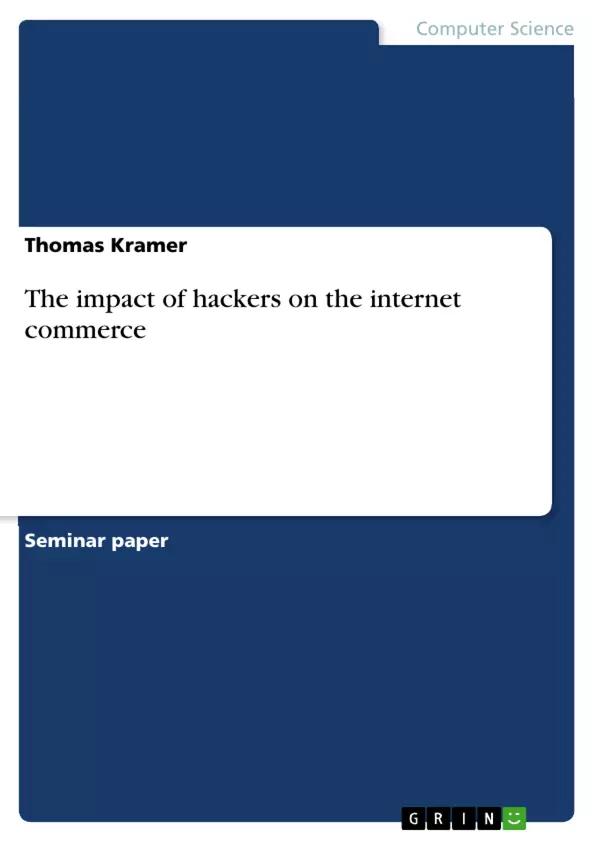The assignment is divided into four main parts. It will start with highlighting several definitions of the term `hacker′, explained by referring to a few examples. At the same time different interpretations of those definitions will be provided and should give the reader an overview over the distinct views towards hackers.
The following section comprises the history as well as the development of the hackers′ scene. It is important to stress how it has changed over the time. Thus one can learn more about the hackers′ intentions and attitudes.
Chapter four is about the motivation of hacking. It should emphasize the different justifications of their activities.
The next section uses the results of the previous sections to highlight the impact of the hacking activity on the internet. From the point of view of companies and governments it is to determine to what extend hackers threaten their ongoing operations.
The assignment will end with a summary and a conclusion of the issues discussed before. Furthermore there will also be an outlook of how the situation could develop in the future as well as the discussion whether or not legislation will be able to solve the threats imposed by hackers.
Inhaltsverzeichnis (Table of Contents)
- INTRODUCTION.
- THE ISSUE OF THE ASSIGNMENT
- THE STRUCTURE OF THE ASSIGNMENT.
- THE TERM 'HACKER'.
- DEFINITION
- THE TERM HACKER IN A BROADER SENSE.
- Phone Phreaking.
- Sport intruders......
- Computer sabotage.
- Computer espionage.
- Computer deceit...
- THE HISTORY AND DEVELOPMENT OF THE HACKING SCENE
- THE BEGINNING..
- The telephone people.
- The computer people.
- THE FURTHER DEVELOPMENT OF THE HACKING SCENE
- THE IMPACT OF TECHNOLOGY ON THE HACKERDOM..
- THE MOTIVATION AND ETHICS OF HACKING.
- THE HACKER'S ETHIC.
- THE IMPROVEMENT OF SECURITY
- THE ACADEMIC MOTIVATION.
- THE PROTECTORS OF THE SOCIETY
- SOCIAL AND POLITICAL REASONS
- CRIMINAL ENERGY..
- IMPENDING THE INTERNET COMMERCE
- THE GENERAL PUBLIC....
- The direct impact.
- The indirect impact.
- BUSINESS AND GOVERNMENT AGENCIES
- DEFENCE ACTIONS.
- CONCLUSIONS.
- SUMMARY
- OUTLOOK
- FINAL STATEMENT
Zielsetzung und Themenschwerpunkte (Objectives and Key Themes)
The assignment examines the impact of hackers on internet commerce, exploring their motivations, historical development, and the threats they pose to various sectors of society. It aims to clarify the term 'hacker' and provide a balanced perspective on their activities.
- Defining the term 'hacker' and its different interpretations.
- Tracing the historical development of the hacking scene.
- Analyzing the motivations and ethics of hacking.
- Assessing the impact of hacking on businesses, governments, and the general public.
- Exploring the potential for future developments in the hacking landscape and the role of legislation.
Zusammenfassung der Kapitel (Chapter Summaries)
The first chapter introduces the assignment's focus on the impact of hackers on internet commerce, outlining the key topics and structure. It highlights the issue of unauthorized access to computer systems and the need to understand the motivations and activities of hackers. The second chapter delves into the definition of 'hacker,' presenting contrasting interpretations and providing a brief overview of the history and development of the hacking scene.
Chapter three expands on the history and development of hacking, highlighting the evolving nature of the scene and the influence of technology on hackerdom. The fourth chapter explores the motivations and ethics of hacking, examining various justifications for their actions, including ethical considerations, academic pursuits, societal protection, and criminal energy. The fifth chapter focuses on the impact of hacking on internet commerce, examining the threats faced by businesses, government agencies, and the general public, and exploring defense strategies against such threats.
Schlüsselwörter (Keywords)
The primary keywords and focus topics include hackers, internet commerce, unauthorized access, computer systems, motivations, ethics, historical development, impact, threats, business, government, defense, legislation, and society. These terms encompass the core concepts and research areas explored in the assignment.
- Citar trabajo
- Thomas Kramer (Autor), 2000, The impact of hackers on the internet commerce, Múnich, GRIN Verlag, https://www.grin.com/document/1893



